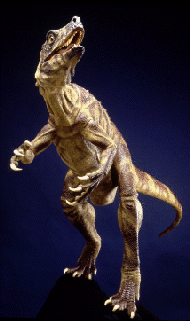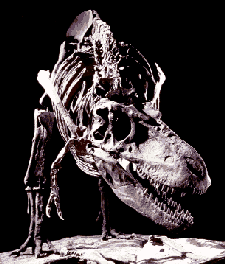


 Herrerasaurus
Herrerasaurus
|
The first one is an example of what a Herrerasaurus might look like with both flesh and skin color.
What do you think? Not quite what one would call pet material! |
I do not know about you, but with just the bones alone, this image leaves no doubt in our mind that this was one dinosaur that did not like broccoli either.
|
 Albertosaurus
Albertosaurus
|
The Mesozoic Era is commonly called the Age of Dinosaurs, although dinosaurs did not originate until near the end of the Triassic. The Mesozoic Era spans a period of time from about 245 million years to 65 million years ago and it is divided into three time periods: the Triassic, Jurassic, and Cretaceous. |
The dinosaurs are a large group of reptiles belonging to the Archosauria ("ruling reptiles"), which also includes the pterosaurs, or "winged lizards"; crocodilians, the only surviving archosaurs; and the thecodonts, primitive "socket tooth" archosaurs, who were the ancestors of all other archosaurs. |
Dinosaurs are classified into two major orders, the Saurischia ("lizard-hipped") and the Ornithischia ("bird-hipped"). The saurischians include of the herbivorous Sauropodomorpha (sauropods and prosauropods) and the carnivorous, bipedal Theropoda. The ornithischians are a more varied group of herbivores, including the stegosaurs, ornithopods, ankylosaurs, and ceratopsians. Modern birds are descended from the theropod dinosaurs. |
These major groups were just developing in Late Triassic time. The Herrerasauria, a Triassic group of primitive bipedal predators, may be ancestral to all dinosaurs, because they had characteristics too primitive to be classified as either saurischian or ornithischian. |
The saurischian dinosaurs of the Triassic are represented by the Coelophysids, a small and primitive family of the theropods, and by the Prosauropods, smaller ancestors to the quadrupedal sauropods. |
The ornithischian dinosaurs are represented by the unclassified Fabrosaurs and a family of very primitive ornithopod known as Heterodontosaurids. Recent discoveries in South America are refining our knowledge of the earliest dinosaurs. |
Dinosaurs have reached a new level of interest and controversy with the purchase of the 65-million-year-old Tyrannosaurus rex, as called T-rex, for $8,362,500 by Chicago’s Field Museum of Natural History. This T-rex discovered it in South Dakota on a Cheyenne River Reservation. This was the most complete T-rex ever discovered, being 90 percent complete, and with over 400 bones. The selling price demonstrates that people find a great interest in dinosaurs, but it also demonstrates that dinosaurs have passed a point of science, and entered the realm of business. How will science suffer from this? |
Unfortunately for us, none of us here have discovered any dinosaur bones, or any of their wonderful reminders. What reminders are those you say? Well, coprolites of course, also known by the more technical term of dino dung! Yes, this creatures left their calling cards in life, but they do not stick to your shoes, or get you that unwanted attention when you walk into the room after accidentally finding some. |
To view a collection of dinosaur images, just click on the image of the dinosaur below. |
 |
